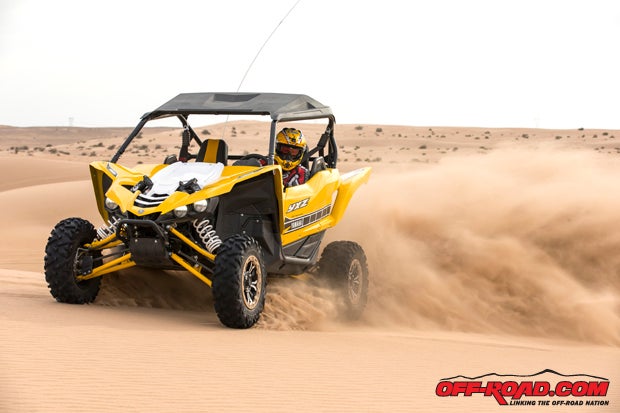
Yamaha’s new 2016 YXZ1000R doesn’t seem real. It has the feel of a futuristic concept vehicle that should be sitting under a tarp waiting to be unveiled at a powersports show. Or maybe it’s one of those outlandish ideas bounced around in a “you know what would be cool?” chat with your buddies that never sees life beyond a napkin sketch.
But there they were, 20 or so YXZ1000Rs nicely parked at the Imperial Sand Dunes near the California/Arizona border. Yamaha invited us out to get a first impression of its new vehicle that somehow got the approval of the suits high in the Yamaha food chain. It’s a bold concept for a vehicle – a manual-shift sport side-by-side – and one we’re frankly surprised got the blessing to be produced.
Get the Flash Player to see this player. |
But we’re happy it exists. And we’re happy to ride it, too.
As surprising as the YXZ1000R might be in some ways, maybe it shouldn’t be a shocker. Considering Yamaha helped construct the foundation of the fastest growing powersports segment with its side-by-side genre-defining Rhino back in 2004, maybe it’s not so crazy that the tuning fork brand is taking a shot at redefining part of the market again.
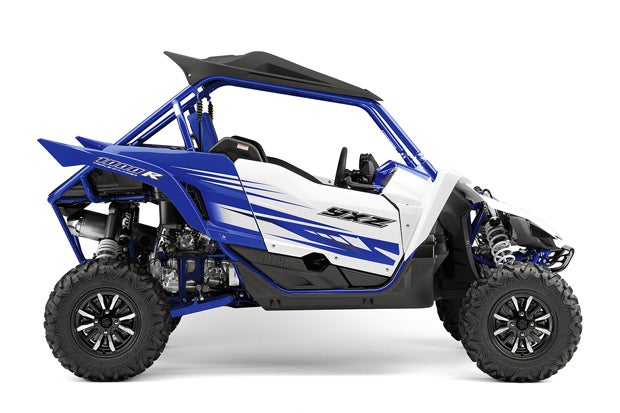
The new YXZ1000R does exactly that – it’s really a new type of vehicle, one the company hails as the first “pure sport” side-by-side. What’s pure sport, you ask? Well, to Yamaha it means forging a stronger connection between driver and vehicle in a performance sense, much like a sports car, streetbike or dirtbike, where driver and machine work in tandem. With clean, untouched dunes and a full day ahead of us, we set out to find out if Yamaha achieved its goal.
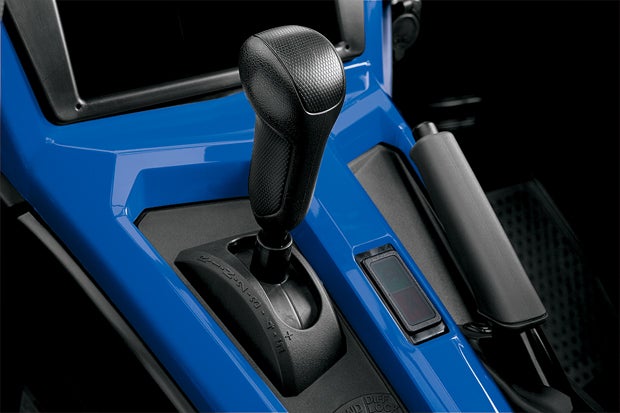
Why is This One Not Like the Others?
Much of the YXZ1000R’s uniqueness has to do with its industry-first five-speed sequential shift gearbox. Yamaha sees this buyer spending a lot of time either in sand or desert terrain where the manual-shift feature can really help the driver push the vehicle to its limits. Fortunately, Yamaha invited us out to the dunes, so we were in an ideal environment to truly get a sense of what the YXZ can offer.
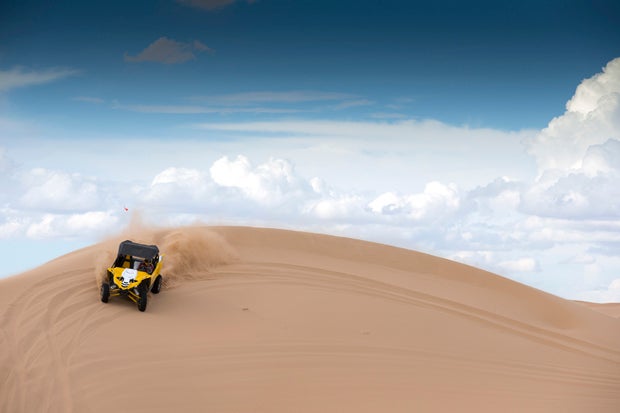
During our ride, we quickly got the hang of the gear shifter and felt that it is relatively easy to use. The manual shifter of the YXZ1000R works in a sequential pattern, meaning it will shift into higher gears by engaging the clutch and pulling the shifter down for higher gears, and then pushing the shifter forward to go back into lower gears, so there’s no H-pattern like a car. A foot-operated pedal controls the hydraulically actuated clutch system, so those not used to driving a manual vehicle will have to overcome that obstacle, but a Rekluse clutch add-on is available to remove the need to use the clutch for gear shifting.

The drivetrain on the YXZ1000R features an external flywheel to help maximize torque and provide ease of shifting. The vehicle is fitted with Yamaha’s On-Command 4WD system, allowing the driving to select 2WD and 4WD with full differential lock mode. The vehicle does of course have reverse, but in an effort to prevent the driver from accidentally finding it, reverse is activated via a lever behind the steering wheel, which once engaged the driver would then push the shifter forward to engage the gear.
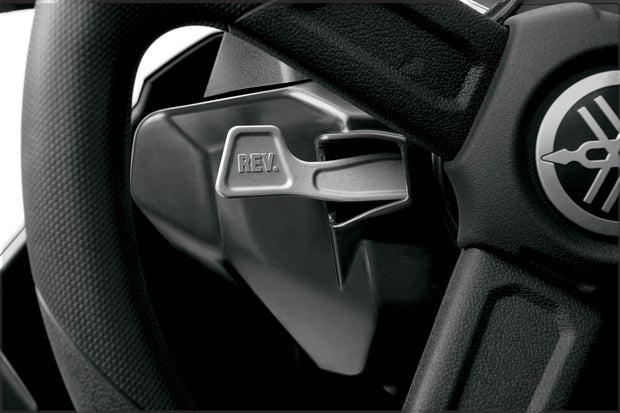
Part of that “pure sport” concept is obvious with this manual-shift side-by-side, but there’s another reason Yamaha went away from the CVT route with the YXZ1000R, and that is because its clutch system helps deliver power up to 20 percent more efficiently. Even if a Rekluse clutch is used, the clutch pedal still can maximize power delivery during holeshot starts or high-performance riding. For added protection, Yamaha also employs its Over-Torque protection system on the machine, which is designed to eliminate spike loads to the front drive case during hard impacts.

Triple Play
Yamaha boasts another first in the YXZ1000R with its 998cc inline triple-cylinder engine, which offers great power and torque and along with a very high 10,500 rpm redline. We were impressed with the engine’s power off the bottom, in the midrange, and even up top – where we noticed there was still plenty of room left to stretch its legs even when we’d shifted into fifth gear. Since Yamaha engineers wanted to place the triple-cylinder engine as low in the chassis as possible for ideal vehicle center of gravity, it uses a dry sump engine design that raises the oil tank above the engine. The dry sump system also helps ensure there’s proper lubrication in the engine regardless of what angle the vehicle may be operating.
The Yamaha engineers on hand were quick to point out how proud they were of the aggressive exhaust note emitted from the machine – and we’d have to agree it does have a nice growl, both while driving and when the machine is fired to life. Yamaha uses a high-flow capacity intake system to feed air to the triple, which features dual air filters (one oiled foam, one oiled paper) to provide maximum airflow while keeping dirt and debris out of the intake. The air inlet is thoughtfully located in the cabin behind the seats, as Yamaha wanted to draw in cool air that’s up and away from the debris of off-road terrain.
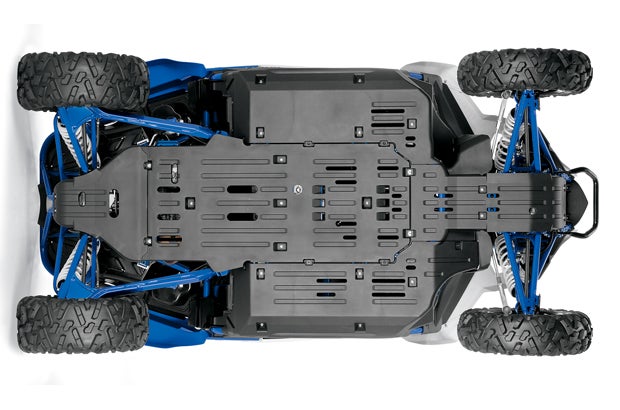
Pure Sport Chariot
Of course, Yamaha had to design an entirely new chassis for the YXZ1000R – there’s no borrowing from the Viking or Wolverine for this sportster. As mentioned, the chassis is designed to set the engine as low as possible for ideal weight distribution and a low COG. This also allowed Yamaha to lower the seat height as well, which it says is 26.4 inches off the ground compared to 29.1 inches on the Polaris RZR. The chassis also provides an impressive 13 inches of ground clearance, which is no doubt aided by the 27-inch Maxxis Bighorn tires fitted on the machine.
Yamaha complemented the powerful engine with an equally impressive suspension system that features Fox Podium RC2 shocks equipped with large piggyback reservoirs to reduce shock fade. Seriously, these units look big enough to fit into a truck or Jeep, and considering they provide 16.2 inches of front travel and 17 inches in the rear, it’s no wonder they are massive. Dialing in the suspension geometry is crucial to the YXZ’s performance, so Yamaha worked hard on the spherical-joint double A-arm suspension to make sure it features ideal castor angle through the suspension’s entire travel range, and this says a lot about why the machine feels so comfortable soaking up bumps and steeps transitions during our ride.
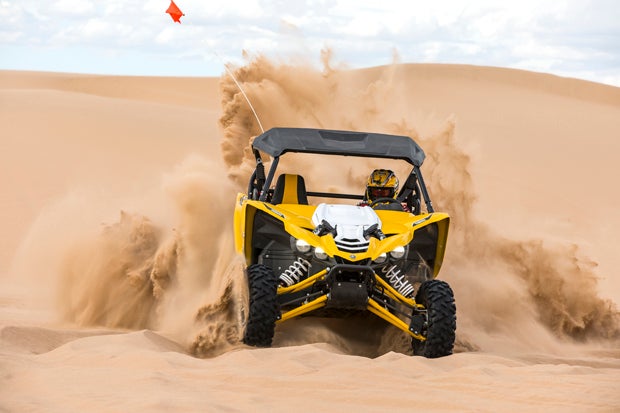
The Fox shocks are fully adjustable for preload, rebound and high- and low-speed compression to get everything dialed for a particular driver or a certain terrain. In the stock setting, which we never felt compelled to change, we thought the shocks were downright impressive. The machine was composed over the biggest, chunkiest whoop sections, and we especially impressed when it soaked up even the harshest downhill transitions at speed. The YXZ doesn’t lack stopping power either, as Yamaha equipped the vehicle with disc brakes on all four corner, with twin-piston calipers seated on 245mm rotors. The vehicle also features a parking brake in the cabin, which we had plenty of chances to use on steep dunes and didn’t notice even the slightest hint of slipping.
The chassis design paired with the Fox shocks is impressive, but it all would be for naught without power steering. Yamaha’s speed-sensitive EPS does provide precise handling that helped to slice through the dunes. Yamaha says the small EPS unit is mounted high on the rack-and-pinion steering system to protect it from dirt and debris. Speaking of protection, Yamaha equipped the YXZ1000R with a full-frame composite underbody skid plate, which is pretty much a necessity on a performance machine that operates in rocky terrain.

In the SE model we tested, the 27-inch Maxxis Bighorn tires are mounted to special edition 14-inch beadlocks, which is why Yamaha could air down the tires to 8 PSI for ideal dune traction – and it’s why we didn’t require paddle tires during our ride. If you plan on riding in the dunes and don’t already have a set of beadlocks, this is one reason to upgrade to the SE model – that, and if you like the Kenny Roberts-inspired yellow paintjob.
The YXZ1000R is not, and never will be, a crossover work machine, though it still can carry some additional gear if properly tied down. Up to 300 pounds can be hauled in the machine in the rear cargo bin. Although sealed storage is pretty minimal there is a small sealed compartment near the cargo area in back, and the glove box can hold a small amount of gear as well.
The YXZ1000R is available in a Blaze Orange/Black color configuration or a Racing Blue and White (with a blue-painted frame, to boot), both of which come with sun tops, starting at $19,799 (it’s $200 more for the blue). Yamaha will also offer the SE model we tested that sports 60th anniversary graphics and beadlock wheels for $21,599.
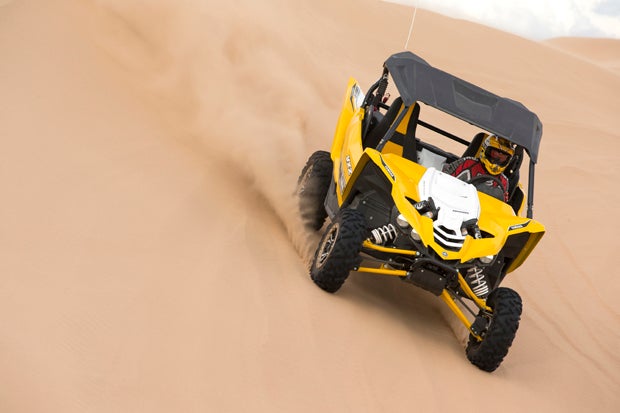
Final Thoughts on a First Impression
Anyone who’s spent much time off-road knows a full day means heading back to your room or camper spent. And spent we were. The only bad thing about our all-day ride aboard Yamaha’s YXZ1000R is that we couldn’t take out the machines again the next morning.
We are impressed with what Yamaha built, and there’s a lot to like about the machine. It’s sporty, it seats two, it’s faster than most side-by-sides you’ll drive, and it cuts through the dunes like a blade. Riding in sand isn’t easy, especially without paddle tires. I’m not the most dune-savvy driver, but I instantly felt comfortable behind the wheel of the YXZ1000R, and for a machine this performance-minded I think that speaks to the quality of the overall package. The engine feels and sounds mean, and sure, there’s a little rattle in the seat of your pants while idling, but it’s really like a Tim “The Toolman” Taylor “arrgghh arggghhh,” rooting you on to engage the clutch and hammer the gas.
Like any true sports machine, the cabin is a tight fit but still comfortable for both driver and passenger. There’s also a nice, sturdy “oh s#*t” bar for the passenger as well. Our only gripe on the driver’s side is the dead pedal sticks out a little farther than we’d like, as the edge closest to the clutch pedal could be trimmed down a bit. But the adjustable steering wheel made it easy to find the sweet spot, and the handling of the machine is impressive. Even when we found ourselves powering into a whoop section with a little more speed than we should, the machine just took it in stride, the suspension soaking up the bumps like they were a foot smaller than they really were. The shifting of the transmission is smooth and easy, and if you’ve ever driven a manual vehicle then picking it up is no problem. When already at speed, we found third gear to be good for hill climbs, and fourth gear is great for cruising through speedy dune transitions. Fifth gear is perfect for high-speed sections, and we were surprised a few times how long it will keep accelerating in top gear. The good news is if you misjudge a transition on one of the dunes, just hop back up into second and let the triple rev higher to get you out of trouble.

Yamaha says it sees the YXZ1000R’s main buyer as being in his late 40s, has a combined house income in the 110,000s, and likely has quite a few years of off-road experience. That’s probably true, as this is the perfect “with age comes the cage” vehicle for the part-time dirtbiker who wants another off-road rig that’s still sporty and “cool.” But we think this vehicle may speak to a large audience, appealing to any off-road enthusiast who loves performance and spends time in the dune and desert, which is where this machine has enough time to stretch its legs.
Yamaha wanted to create something cool and different, and to that we say mission accomplished. The YXZ1000R owns the pure sport category at this point, and it’s possible Yamaha did such a good job with the machine that we may never see a direct competitor to it.


 Your Privacy Choices
Your Privacy Choices